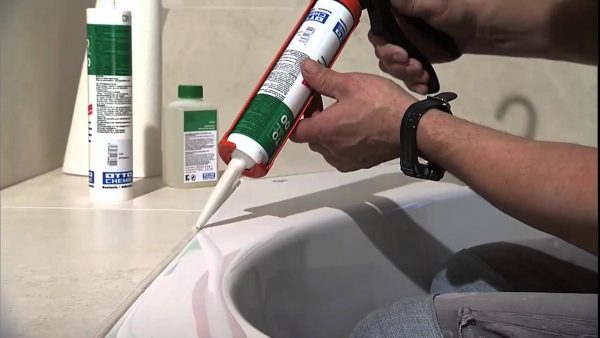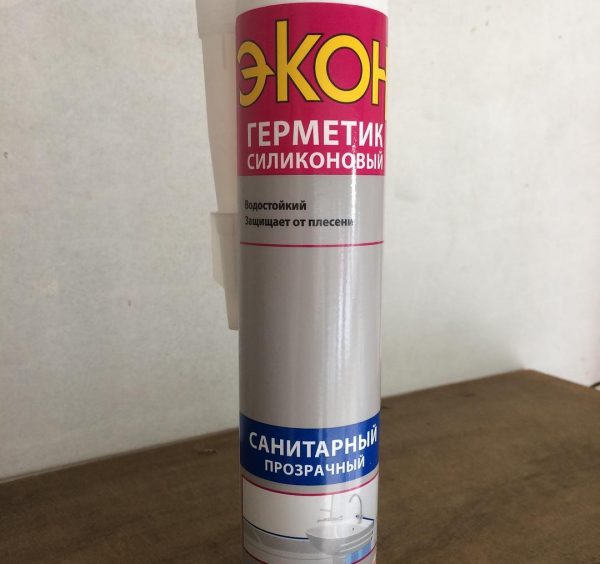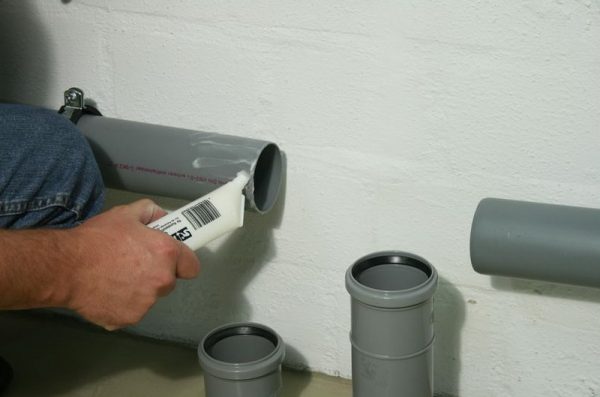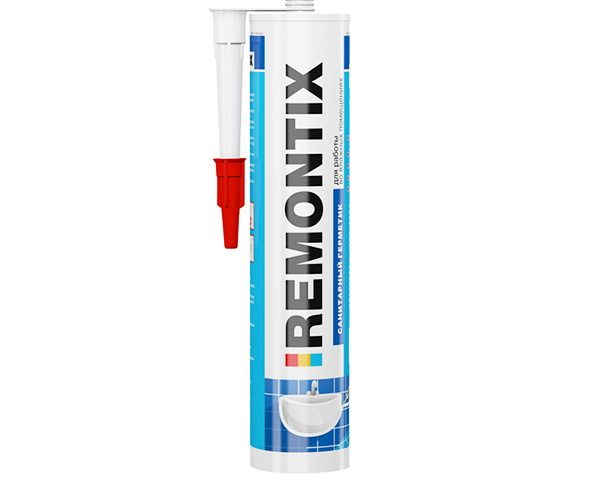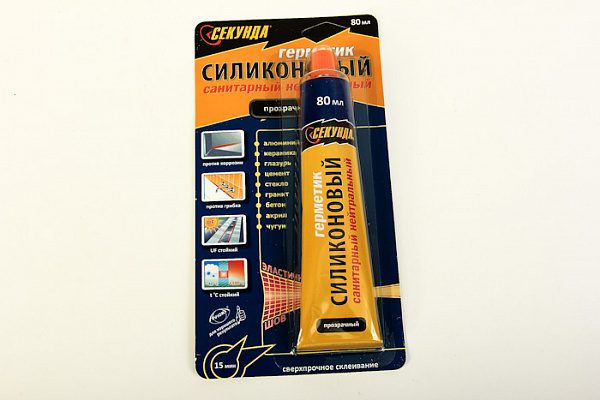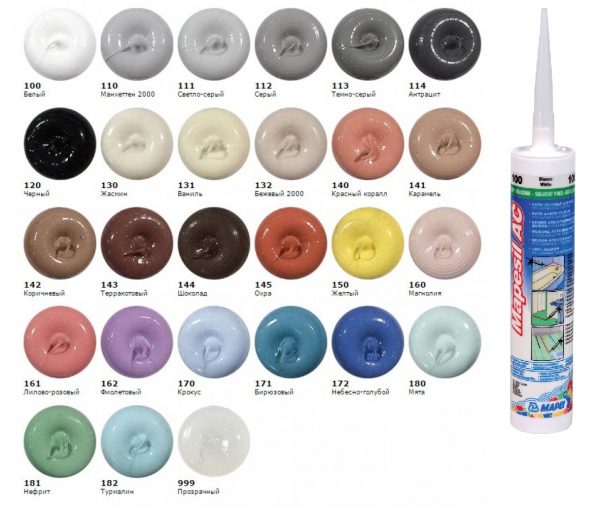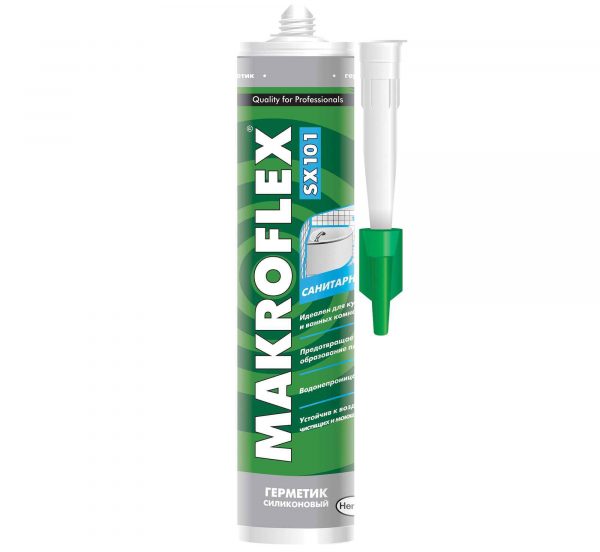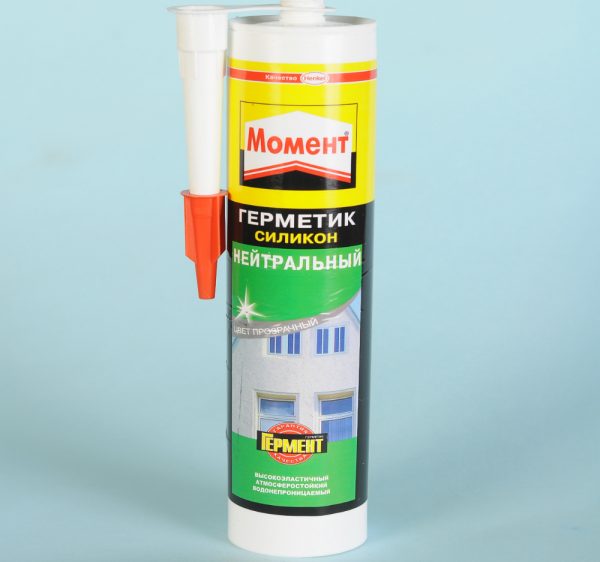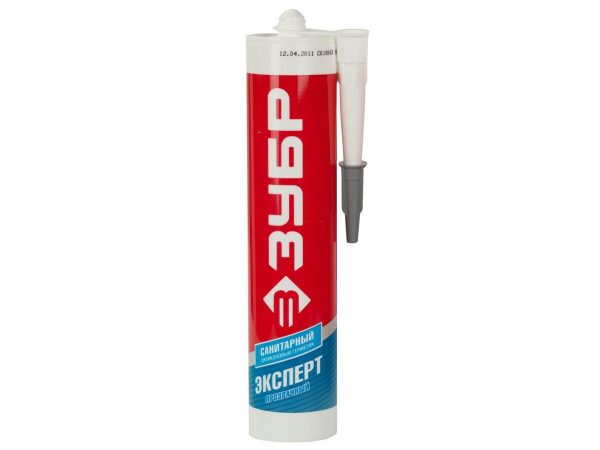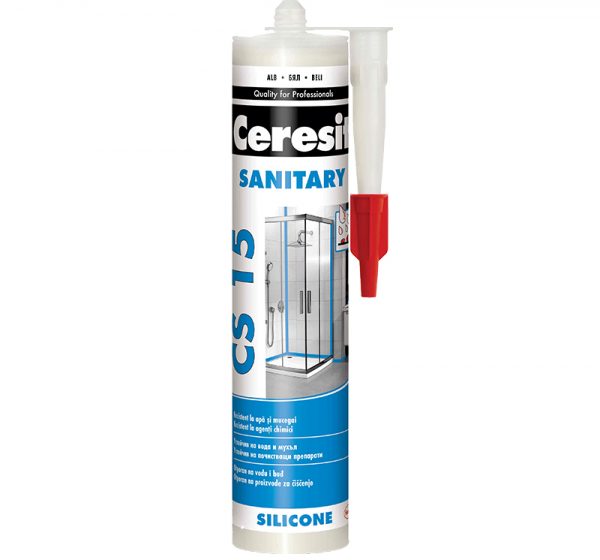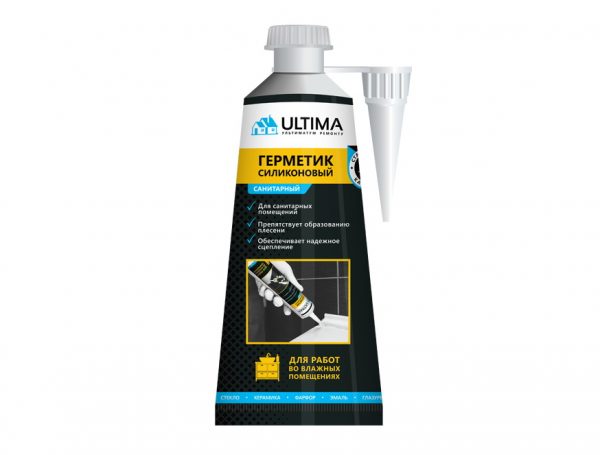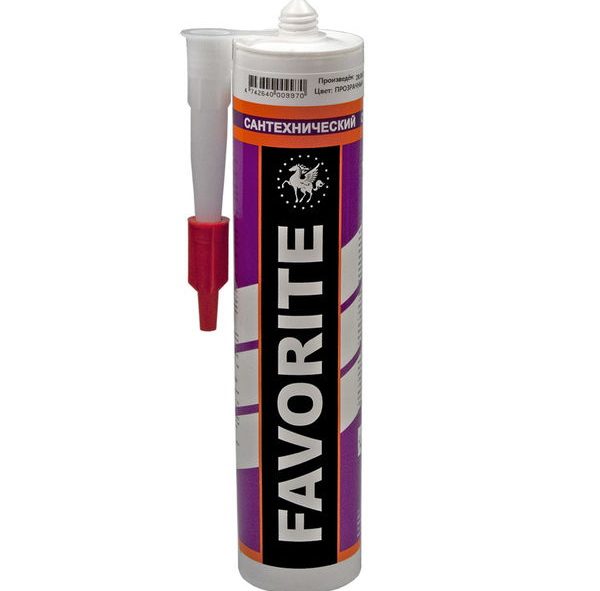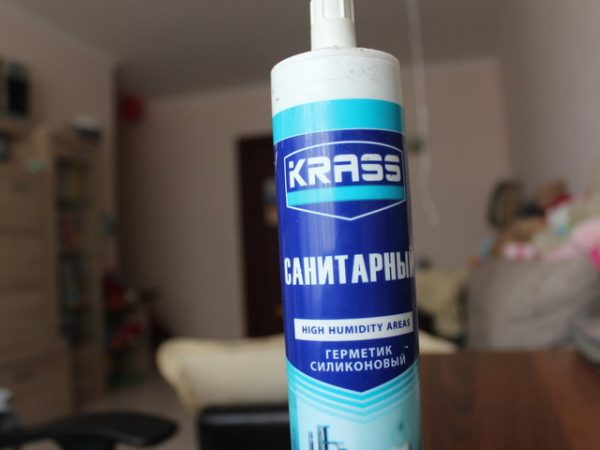For sealing joints, joints, various cracks, sealing compounds are traditionally used. They are especially popular in the kitchen and in the bathroom, where humidity is constantly increased, mold often appears. Sanitary sealant is the most suitable remedy for such purposes: it can be used to eliminate surface defects and "cure" the fungus on different bases.
- Features of sanitary sealants
- Purpose, composition and properties
- Varieties of sanitary silicone sealants
- Acid Sealants
- Neutral sealants
- Color spectrum
- How to apply sanitary sealant
- Popular manufacturers and reviews
- Makroflex SX 101
- Kudo Silicone Sanitary
- “The moment of Germent Sanitary”
- Soudal - Neutral Sanitary Silicone
- "Bison Sanitary"
- Tytan Sanitary UPG
- Ceresit cs 15
- Krass
- Kiilto Saniteettisilikoni
- Ultima
- Profil Universal Silicone
- Favorite
- Econ
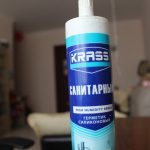
Features of sanitary sealants
Sanitary silicone sealant is a homogeneous paste-like composition made on the basis of silicone with the addition of polymers and additional substances. Such compositions are designed to fill and seal joints, crevices, cracks, pits, chips, to prevent them from filling with dust, dirt, and also to protect the material from air and water.
Among the whole variety of sealants, it is silicone that is the most popular in everyday life. Compositions based on silicone rubber are considered universal and are most often used in the toilet, bathroom, kitchen, because building materials there are exposed to various damaging factors:
- high humidity;
- temperature differences;
- mechanical stress.
In addition, sealants help maintain proper hygiene in these rooms, which is why they got their name. Such products do not rot, are not afraid of water, mold. The main difference between a sanitary sealant and a simple one is fungicidal additives - substances that destroy fungal and other organic deposits.
to contents ↑Purpose, composition and properties
In addition to the base - silicone, other substances are present in the sealants. Plasticizers that enhance elasticity, thixotropic components are introduced here. The latter give the structure special properties that allow it to solidify at rest and liquefy when moving, they help the sealant not to drain from vertical bases.
Also, sanitary sealants must include:
- anti-mold additives (fungicides);
- hydrophobic substances;
- adhesion primers;
- catalysts and vulcanizing components;
- pigments
- fillers.
Sanitary sealants can be used when laying sewer pipes, processing joints and cracks, window frames, when filling cracks. They are widely used in the installation of kitchen equipment, plumbing, for insulation during repair, electrical work.
Using sealant, you can glue the tiles, grout tile joints. It is suitable for most materials used for repair and construction.
Restrictions on the operation of sanitary silicone sealants also exist. They do not adhere well to fluoroplastic, polycarbonate, polyethylene, so these materials require the use of a different type of sealing compounds.Also, many sanitary sealants are not suitable for products in contact with water, food related to animals (for example, for aquariums). They contain additives that make the product harmful if it gets directly into the body. For utensils and other kitchen utensils, it is worth buying special compounds marked with food safety.
Any sanitary sealant is moisture resistant, which means it is well suited for the bathroom. Due to the presence of special components, sealants are resistant to mechanical stress, UV radiation, they withstand frost and heat, temperature changes, are not afraid of precipitation, therefore they are suitable even for outdoor work (for example, to seal facades or greenhouses). Good sealants do not shrink at all or its rate does not exceed 2%.
Each sealant dries during a different time period, although the drying of any of them depends on humidity and temperature in the room. For example, if the temperature is room temperature, the humidity is about 60%, then the surface film is formed in 5-15 minutes, complete curing occurs in a day. Thick, large seams dry longer - in 2-4 days.
to contents ↑Varieties of sanitary silicone sealants
The vulcanization reaction of the sealant always starts with the participation of moisture that is present in the air. Depending on the type of product, different substances are released during such a reaction: for some sealants this is acetic acid, for others it is harmless alcohols and water. On this basis, the compounds are divided into acidic and neutral (without acetic acid).
Acid Sealants
Such funds are most common in everyday life, since they are inexpensive, are sold everywhere. They have a fairly high adhesion to the tiles, some types of plastic, waterproof, contain antifungal additives. Nevertheless, acidic sealants have a significant minus. They are not suitable for all materials: in contact with some of them, undesirable reactions begin.
For example, after getting acetic acid on metals, premature corrosion begins. Mirrors with a thin amalgam darken, become stained and stained, cement “fills” with a layer of white salt, marble and limestone begin to crumble. Also, the products have an unpleasant odor, and you need to work with them with strict observance of safety measures.
to contents ↑Neutral sealants
The best sanitary sealant is neutral. It is suitable even for surfaces that may be damaged by acidic compounds. Such products are chemically inert, that is, do not react with surfaces and the environment. Most often, neutral sealants are used on acrylic and PVC substrates; they show no less good adhesion to porcelain, metal, ceramics, glass, and enameled materials. The only disadvantage is the high price.
to contents ↑Color spectrum
Among sanitary sealants, white and transparent compositions are most often found, and both groups are approximately equally in demand. They are ideal for processing joints, sealing plumbing, sealing cracks. Colorless compositions after application remain almost invisible and do not catch the eye even on bright household items.
There are also black, beige, brown, gray compounds on sale. Usually they are selected for the installation of pipes of the corresponding shade so that the joints do not stand out too much on the surface. Other color options in stores are less common, although there are even red sealants - they isolate the wiring. It is impossible to color the composition on your own, because this only happens in the production process. But some products allow staining of finished joints after drying, which is always indicated on the packaging.
to contents ↑How to apply sanitary sealant
Before starting work, you need to carefully prepare the surface, especially if it has previously been sealed. Dust, dirt, any deposits should be removed, degreased by washing or rubbing with alcohol, acetone. Immediately before applying the sealant, the joints and joints are dried.
The old sealant must be completely removed, using a clerical knife, spatulas, wire, in difficult cases - chemical washes, dissolving compounds. The sealant is removed from metal, ceramics, glass with solvent-based cleaning agents, then wiped the bases dry with a napkin.
After the edge of the surfaces that will be in contact with the sealing compound, they are pasted over with masking tape. Immediately after completion of work, the adhesive tape is completely removed.
It is desirable that the sealant has room temperature, and in the room it was within + 5 ... + 40 degrees. If possible, humidity should be brought closer to 50-60%: in the bathroom, you can ventilate for this by opening the doors wide. Further, the procedure will be as follows:
- cut off the tip of the sealant cartridge at an angle of 45 degrees, insert into a special glue gun;
- start extruding the composition in an even layer, avoiding the appearance of clots and line breaks: press the trigger with equal force, while monitoring the filling of the entire crack, seam;
- smooth the sealant layer with a rubber spatula dampened with water or a wet cloth (this can only be done before the film is formed);
- tear off all the adhesive tape that was pasted, remove excess composition with the rough side of the sponge or spatula.
Before starting to use the surfaces, you must wait the time, which is enough until the composition is completely cured (in the instructions for use, you can always find an indication for this period). The more additives and additives in the product, the longer it hardens. The thickness of the seam, temperature and humidity also seriously affect the duration of this period. To speed up the process, you can do the following:
- optimize ventilation;
- increase air temperature;
- sprinkle over a seized film with water from a spray bottle.
Popular manufacturers and reviews
Among the variety of sanitary sealants, you can literally get confused. Below are the most famous of them, which are appreciated by professionals.
Makroflex SX 101
Henkel’s German Makroflex sealant is acidic and designed to protect surfaces in humid areas. The product is characterized by excellent adhesion to PVC, ceramics, glass, enamel, as well as stainless steel and aluminum. The composition does not give a negative reaction to the influence of UV radiation, ozone, does not wear off for a long time, and is effective against fungus and mold. When applied, the product manifests itself as an unpleasant vinegar odor, but as it solidifies, it disappears.
to contents ↑Kudo Silicone Sanitary
Highly elastic, durable, reliable sanitary sealant. It does not fade, does not collapse over time, is resistant to any, even the most aggressive environment, does not deteriorate from the action of household chemicals. Thanks to antiseptics and fungicides, the sealant prevents harmful microorganisms from multiplying. Since the product is neutral in composition, it combines perfectly with any materials, it does not damage even concrete and natural stone.
to contents ↑“The moment of Germent Sanitary”
This is a high-quality sealant designed for rooms with high humidity. It is also suitable for sealing windows, wooden structures, joints in concrete, suitable for work on enameled surfaces. Despite the acidic curing system, Moment Germent does not lead to the destruction of delicate bases and has limitations in its use only with respect to metals. The tool is ideal for wide and deep seams.
The sealant has a fairly long service life, but after 2 years, the seam may darken slightly. It is resistant to UV radiation, precipitation, various chemical effects. On the downside, there is a persistent vinegar smell when applied, which later disappears without a trace. Work with sealant only in a well-ventilated area and with personal protective measures.
to contents ↑Soudal - Neutral Sanitary Silicone
The product is made in Belgium, is neutral, as it does not contain acids. It can be used on a variety of materials: marble, concrete, brick, granite, glass, PVC without risk of damage. Using Soudal sealant, it is possible to seal joints between the wall and the bathroom, the tray, the sink made of acrylic, polyacrylic, polycarbohydrate and other materials. The product has a convenient paste-like consistency, easy to apply, is available in white.
to contents ↑"Bison Sanitary"
Frost-resistant sealant "Bison" is excellent for outdoor applications, can also be used indoors, but is not intended for constant contact with moisture. It has a viscous consistency, so it does not flow from vertical bases. The sealant is evenly applied, easily extruded, can be painted in any shade, characterized by resistance to chemical attack and long service life. Typically, "Bison" is used to seal doors and windows, in facade work, during the installation of ventilation systems.
to contents ↑Tytan Sanitary UPG
Under the Tytan brand, several sealants are produced, but this one is produced using the new UPG technology (Upper Protection Grade) and is characterized by a high content of bactericidal and antifungal components. The product has an acid curing principle, and boasts excellent adhesion to non-porous substrates (ceramics, glass, PVC, enamel). Most often, sealant is used to seal joints between tiles and fixtures, to seal joints of shower cabins, during minor repairs.
to contents ↑Ceresit cs 15
Ceresit high-quality sealant has a high degree of adhesion to most materials used in interior decoration. It quickly sets when interacting with moist air, is convenient to use, there is a mark on the nose, along which the tube is trimmed. The tool best fastens ceramics, enameled surfaces, glass, while poorly in contact with bitumen and materials based on it. It is not recommended to use sealant for joints that are in water or are subject to strong mechanical wear.
to contents ↑Krass
Sealant Krass is characterized by excellent plasticity, waterproof, easy to apply and can be easily removed from the hands. Over time, the sealant does not turn yellow, its smell is very weak and quickly disappears. The product is suitable for smooth and porous substrates, but it can only be applied on a dry surface.
Kiilto Saniteettisilikoni
Finnish sealant Kiilto Saniteettisilikoni has a large percentage of solids, so it is quite thick, does not flow on vertical bases. It is characterized by high heat resistance, goes well with any natural stone, as it is neutral. Available in different color variations (beige, yellow, gray, orange, graphite, red, sand and many others).
Ultima
Silicone sealant Ultima - a material necessary for plumbing, used outdoors and indoors. It is suitable for tiles, wood, plastic, glass, ceramics, helps in sealing gutters, air conditioning systems, sewers. Using this sealant, drafts and leaks can be eliminated. It dries quickly, highly elastic, resistant to moisture and UV rays.
to contents ↑Profil Universal Silicone
Profil Universal Silicone Sanitary Sealant is a one-component, acid-based multi-purpose compound. After curing, it forms a durable joint, resistant to temperature changes, the influence of the sun, while its physical properties are preserved for many years. The sealant is ideal for smooth substrates, especially tiles and glass.
Favorite
This composition is obtained by using modern technology, it includes special compounds of organic silicon, enhancing viscosity and adhesion. With Favorite sanitary sealant, you can repair any cracks and seal joints when working with plastic, laminate, glass, ceramics, wood, and plaster. The sealant is not stainable and is sold only as a white paste.
to contents ↑Econ
The universal silicone sealant "Econ" is suitable for sealing joints outdoors and indoors. It can be used on smooth substrates, aluminum, waterproof, flexible, resistant to atmospheric and chemical effects.The composition has a high speed of film formation and final curing, convenient to use, has an economical expense and low cost.

